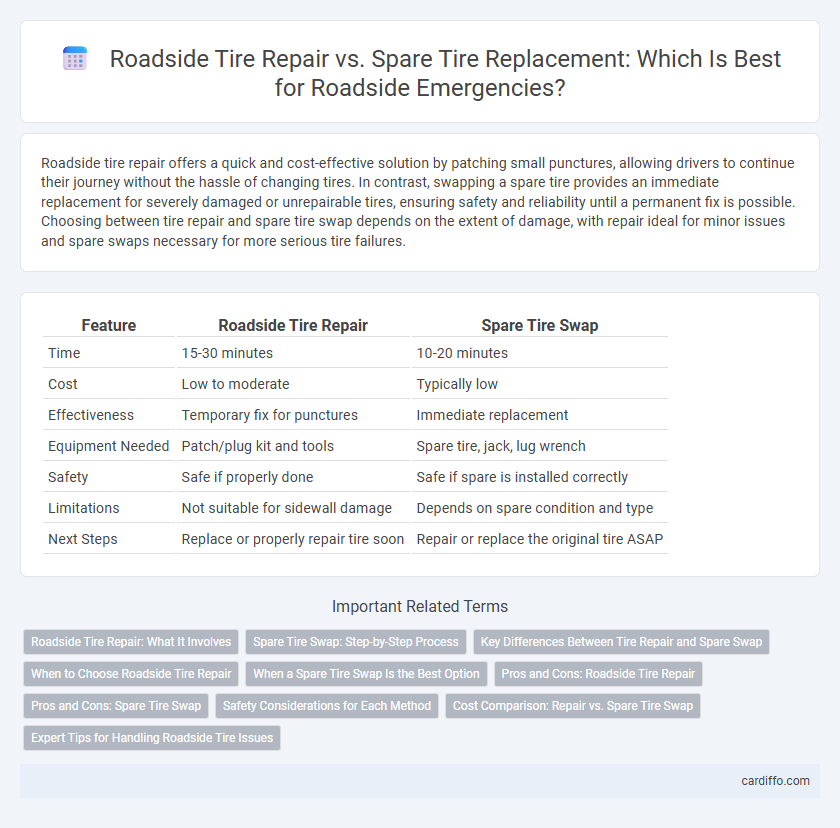Roadside tire repair offers a quick and cost-effective solution by patching small punctures, allowing drivers to continue their journey without the hassle of changing tires. In contrast, swapping a spare tire provides an immediate replacement for severely damaged or unrepairable tires, ensuring safety and reliability until a permanent fix is possible. Choosing between tire repair and spare tire swap depends on the extent of damage, with repair ideal for minor issues and spare swaps necessary for more serious tire failures.
Table of Comparison
| Feature | Roadside Tire Repair | Spare Tire Swap |
|---|---|---|
| Time | 15-30 minutes | 10-20 minutes |
| Cost | Low to moderate | Typically low |
| Effectiveness | Temporary fix for punctures | Immediate replacement |
| Equipment Needed | Patch/plug kit and tools | Spare tire, jack, lug wrench |
| Safety | Safe if properly done | Safe if spare is installed correctly |
| Limitations | Not suitable for sidewall damage | Depends on spare condition and type |
| Next Steps | Replace or properly repair tire soon | Repair or replace the original tire ASAP |
Roadside Tire Repair: What It Involves
Roadside tire repair involves assessing and fixing minor tire damages like punctures using specialized tools and sealing materials without removing the tire. Technicians inspect the tire's tread and sidewall integrity to determine repair feasibility, ensuring safe driving conditions post-repair. This service offers a quick, cost-effective alternative to spare tire swaps by restoring the original tire without needing immediate replacement.
Spare Tire Swap: Step-by-Step Process
Spare tire swap involves safely parking the vehicle on a flat surface and engaging the parking brake before loosening the lug nuts with a tire iron. After lifting the car with a jack placed at the designated jacking point, the flat tire is removed and the spare tire is mounted onto the hub, followed by tightening the lug nuts by hand. Lower the vehicle, then fully tighten the lug nuts in a star pattern to ensure proper torque and road safety.
Key Differences Between Tire Repair and Spare Swap
Roadside tire repair involves fixing punctures or minor damage directly on the affected tire, preserving the original tire's performance and alignment, whereas a spare tire swap replaces the damaged tire with a temporary spare, which is typically smaller and designed for limited use. Tire repair is cost-effective and maintains vehicle safety as long as the damage is within repairable limits, while spare tire swaps offer immediate mobility but require prompt replacement of the spare with a full-size tire. Understanding these key differences helps drivers make informed decisions during roadside emergencies, balancing convenience, safety, and long-term tire health.
When to Choose Roadside Tire Repair
Roadside tire repair is ideal when the damage is minor, such as small punctures or slow leaks, allowing you to restore tire pressure quickly and safely without the need for a full tire replacement. It offers a cost-effective and time-saving solution compared to a spare tire swap, especially when the original tire is still structurally sound and repairable. Choosing roadside repair helps maintain tire integrity and ensures continued optimal performance until a professional inspection or permanent fix can be performed.
When a Spare Tire Swap Is the Best Option
A spare tire swap is the best option when immediate road safety is a priority, allowing drivers to regain mobility quickly without waiting for extensive repairs. This method is ideal for punctures or minor tire damage, enabling a temporary yet reliable solution until a professional repair or replacement can be arranged. Choosing a spare tire swap minimizes downtime and reduces the risk of further damage or accidents on busy roads.
Pros and Cons: Roadside Tire Repair
Roadside tire repair offers a quick and cost-effective solution for minor punctures, allowing drivers to avoid the inconvenience of changing tires on the spot. Repairs preserve the original tire, maintaining vehicle balance and alignment, which can be compromised during a spare tire swap. However, roadside repairs are limited to small damages and may not be suitable for sidewall or large tread injuries, potentially requiring a full replacement later.
Pros and Cons: Spare Tire Swap
Spare tire swaps provide a fast and convenient solution for temporarily replacing a flat tire, allowing drivers to continue their journey without waiting for repair services. However, spare tires are often smaller and designed for short-term use, limiting speed and distance, which may necessitate prompt tire repair or replacement. While easy to install, relying solely on a spare tire can risk vehicle stability and safety if driven extensively.
Safety Considerations for Each Method
Roadside tire repair often involves fixing punctures with plugs or patches, providing a temporary solution that allows safe driving to the nearest service center but may not be suitable for severe damage. A spare tire swap offers an immediate replacement, restoring full tire integrity and ensuring vehicle stability, critical for safe travel over longer distances. Prioritizing tire condition and proper installation during either method is essential to prevent accidents and maintain optimal road safety.
Cost Comparison: Repair vs. Spare Tire Swap
Roadside tire repair typically costs between $20 and $50, making it a more affordable option compared to a spare tire swap, which can range from $50 to $100 depending on labor and location. Repairing a punctured tire extends its lifespan and reduces the need for immediate replacement, offering long-term savings. Spare tire swaps often involve additional expenses, such as replacement spare purchase and potential damage from improper installation.
Expert Tips for Handling Roadside Tire Issues
For roadside tire issues, expert tips recommend assessing the tire damage before deciding between repair or a spare tire swap. Temporary repair kits can fix minor punctures, preserving the original tire while enabling safer travel to a repair shop. When tread damage or sidewall cuts occur, swapping with a properly inflated spare tire ensures immediate safety and prevents further vehicle damage.
Roadside tire repair vs spare tire swap Infographic

 cardiffo.com
cardiffo.com